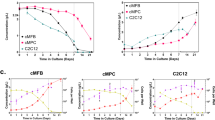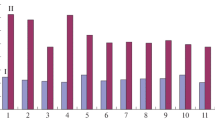Abstract
The growth of mammalian cells in vitro requires the use of rich culture media that are prepared by combining serum with specific nutrient formulations. Serum, the most expensive component of culture media, provides a complex mixture of growth factors and nutrients. Protein hydrolysates that can support in vitro cell growth and eliminate or reduce the need to use serum have been obtained from different sources. Here we describe the use of two food grade proteases to produce a chickpea protein hydrolysate that has been added to cell culture medium in order to determine whether it can be used as a substitute for serum. Medium containing the hydrolysate has been tested using two human cells lines: the monocytic THP-1 cell line which grows in suspension, and the epithelial Caco-2 cell line which grows as a monolayer. The chickpea protein hydrolysate was a good substitute for serum in the first case, but did not allow growth of Caco-2 cells. Supplementation of culture media with this inexpensive and safe hydrolysate would greatly reduce the cost of cell culture.






Similar content being viewed by others
References
Adler-Nissen J (1979) Determination of the degree of hydrolysis of food protein hydrolysates by trinitrobenzenesulfonic acid. J Agric Food Chem 27:1256–1262. doi:10.1021/jf60226a042
Alaiz M, Navarro JL, Girón J, Vioque E (1992) Amino acid analysis by high-performance liquid chromatography after derivatization with diethyl ethoxymethylenemalonate. J Chromatogr 591:181–186. doi:10.1016/0021-9673(92)80236-N
Ballez JS, Mols J, Burteau C, Agathos SN, Schneider YJ (2004) Plant protein hydrolysates support CHO–320 cells proliferation and recombinant IFN-gamma production in suspension and inside microcarriers in protein-free media. Cytotechnology 44:103–114. doi:10.1007/s10616-004-1099-2
Burteau CC, Verhoeye FR, Mols JF, Ballez JS, Agathos SN, Schneider YJ (2003) Fortification of a protein-free cell culture medium with plant peptones improves cultivation and productivity of an interferon-gamma-producing CHO cell line. In Vitro Cell Dev Biol Anim 39:291–296. doi:10.1290/1543-706X(2003)039<0291:FOAPCC>2.0.CO;2
Clemente A, Vioque J, Sanchez-Vioque R, Pedroche J, Bautista J, Millan F (1999a) Protein quality of chickpea (Cicer arietinum L.) protein hydrolysates. Food Chem 67:269–274. doi:10.1016/S0308-8146(99)00130-2
Clemente A, Vioque J, Sanchez-Vioque R, Pedroche J, Millan F (1999b) Production of extensive chickpea (Cicer arietinum L.) protein hydrolysates with reduced antigenic activity. J Agric Food Chem 47:3776–3781. doi:10.1021/jf981315p
Deparis V, Durrieu C, Schweizer M, Marc I, Goergen JL, Chevalot I, Marc A (2003) Promoting effect of rapeseed proteins and peptides on Sf9 insect cell growth. Cytotechnology 42:75–85. doi:10.1023/B:CYTO.0000009816.65227.84
Franek F, Katinger H (2002) Specific effects of synthetic oligopeptides on cultured animal cells. Biotechnol Prog 18:155–158, doi:10.1021/bp0101278
Franek F, Hohenwarter O, Katinger H (2000) Plant protein hydrolysates: preparation of defined peptide fractions promoting growth and production in animal cells cultures. Biotechnol Prog 16:688–692. doi:10.1021/bp0001011
Franek F, Eckschlager T, Katinger H (2003) Enhancement of monoclonal antibody production by lysine-containing peptides. Biotechnol Prog 19:169–174. doi:10.1021/bp020077m
Frokjaer S (1994) Use of hydrolysates for protein supplementation. Food Technol 48:86–88
Ganjam LS, Thornton WH Jr, Marshall RT, MacDonald RS (1997) Antiproliferative effects of yogurt fractions obtained by membrane dialysis on cultured mammalian intestinal cells. J Dairy Sci 80:2325–2329
Giovannini C, Sanchez M, Straface E, Scazzocchio B, Silano M, De Vincenzi M (2000) Induction of apoptosis in Caco-2 cells by wheat gliadin peptides. Toxicology 145:63–71. doi:10.1016/S0300-483X(99)00223-1
Girón-Calle J, Vioque J, Yust M, Pedroche J, Alaiz M, Millan F (2004) Effect of chickpea aqueous extracts, organic extracts, and protein concentrates on cell proliferation. J Med Food 7:122–129. doi:10.1089/1096620041224175
Gu XJ, Xie LZ, Harmon BJ, Wang DIC (1997) Influence of Primatone RL supplementation on sialylation of recombinant human interferon-gamma produced by Chinese hamster ovary cell culture using serum-free media. Biotechnol Bioeng 56:353–360. doi:10.1002/(SICI)1097-0290(19971120)56:4<353::AID-BIT1>3.0.CO;2-N
Heidemann R, Zhang C, Qi HS, Larrick Rule J, Rozales C, Park S, Chuppa S, Ray M, Michaels J, Konstantinov K et al (2000) The use of peptones as medium additives for the production of a recombinant therapeutic protein in high density perfusion cultures of mammalian cells. Cytotechnology 32:157–167. doi:10.1023/A:1008196521213
Jan DCH, Jones SJ, Emery AN, Alrubeai M (1994) Peptone, a low-cost growth-promoting nutrient for intensive animal-cell culture. Cytotechnology 16:17–26. doi:10.1007/BF00761775
Karczewski JM, Peters JG, Noordhoek J (1999) Prevention of oxidant-induced cell death in Caco-2 colon carcinoma cells after inhibition of poly (ADP-ribose) polymerase and Ca2+ chelation: involvement of a common mechanism. Biochem Pharmacol 57:19–26. doi:10.1016/S0006-2952(98)00286-X
Kayser H, Meisel H (1996) Stimulation of human peripheral blood lymphocytes by bioactive peptides derived from bovine milk proteins. FEBS Lett 383:18–20. doi:10.1016/0014-5793(96)00207-4
Keenan J, Pearson D, Clynes M (2006) The role of recombinant proteins in the development of serum-free media. Cytotechnology 50:49–56. doi:10.1007/s10616-006-9002-y
Kitts DD (1994) Bioactive substances in food: identification and potential uses. Can J Physiol Pharmacol 72:423–434
Kops SK, West AB, Leach J, Miller RH (1997) Partially purified soy hydrolysates retard proliferation and inhibit bacterial translocation in cultured C2BBe cells. J Nutr 127:1744–1751
Meisel H, Bockelmann W (1999) Bioactive peptides encrypted in milk proteins: proteolytic activation and thropho-functional properties. Antonie Van Leeuwenhoek 76:207–215. doi:10.1023/A:1002063805780
Mols J, Peeters-Joris C, Wattiez R, Agathos SN, Schneider YJ (2005) Recombinant interferon-T secreted by Chinese hamster ovary-320 cells cultivated in suspension in protein-free media is protected against extracellular proteolysis by the expression of natural protease inhibitors and by the addition of plant protein hydrolysates to the culture medium. In Vitro Cell Dev Biol Anim 41:83–91. doi:10.1290/0411075.1
Pedroche J, Yust MM, Giron-Calle J, Alaiz M, Millan F, Vioque J (2002) Utilisation of chickpea protein isolates for production of peptides with angiotensin I-converting enzyme (ACE)-inhibitory activity. J Sci Food Agr 82:960–965. doi:10.1002/jsfa.1126
Pincock S (2007) Meat, in vitro? Scientist 21:22–23
Ravallec Ple R, Gilmartin L, Wormhoudt AV, Gal Y (2000) Influence of the hydrolysis process on the biological activities of protein hydrolysates from cod (Gadus morhua) muscle. J Sci Food Agr 80:2176–2180. doi:10.1002/1097-0010(200012)80:15<2176::AID-JSFA763>3.0.CO;2-G
Ravallec Ple R, Charlot C, Pires C, Braga V, Batista I, Wormhoudt A, Gal Y, Fouchereau Peron M (2001) The presence of bioactive peptides in hydrolysates prepared from processing waste of sardine (Sardina pilchardus). J Sci Food Agr 81:1120–1125. doi:10.1002/jsfa.921
Rivabene R, Mancini E, De Vincenzi M (1999) In vitro cytotoxic effect of wheat gliadin-derived peptides on the Caco-2 intestinal cell line is associated with intracellular oxidative imbalance: implications for coeliac disease. Biochim Biophys Acta 1453:152–160
Rocca E, Paganuzzi Stammati A, Zampaglioni F, Zucco F (1983) Effects of gliadin-derived peptides from bread and durum wheats on in vitro cultures of human cell lines. Implications for coeliac disease pathogenesis. Toxicol Lett 16:331–338. doi:10.1016/0378-4274(83)90195-9
Sánchez-Vioque R, Clemente A, Vioque J, Pedroche J, Bautista J, Millan F (1999) Protein isolates from chickpea (Cicer arietinum L.): chemical composition, functional properties and protein characterization. Food Chem 64:237–243. doi:10.1016/S0308-8146(98)00133-2
Schlaeger EJ (1996) The protein hydrolysate, Primatone RL, is a cost-effective multiple growth promoter of mammalian cell culture in serum-containing and serum-free media and displays anti-apoptosis properties. J Immunol Methods 194:191–199. doi:10.1016/0022-1759(96)00080-4
Silano M, De Vincenzi M (1999) Bioactive antinutritional peptides derived from cereal prolamins: a review. Nahrung 43:175–184. doi:10.1002/(SICI)1521-3803(19990601)43:3<175::AID-FOOD175>3.0.CO;2-Z
Taylor WG, Evans VJ, Pumper RW (1974) Studies on a serum substitute for mammalian-cells in culture 2. Analyses of fractionated peptone dialysate and use of glycine peptides. In Vitro-J Tissue Cult Assoc 9:278–285
Taylor WG, Dworkin RA, Pumper RW, Evans VJ (1972a) Biological efficacy of several commercially available peptones for mammalian-cells in culture. Exp Cell Res 74:275. doi:10.1016/0014-4827(72)90505-8
Taylor WG, Taylor MJ, Pumper RW, Lewis NJ (1972b) Studies on a serum substitute for mammalian-cells in culture. 1. Biological efficacy of whole and fractionated peptone dialysate. Proc Soc Exp Biol Med 139:96
Vioque J, Clemente A, Pedroche J, Yust MM, Millan F (2001) Obtención y aplicaciones de hidrolizados proteicos. Grasas y Aceites 52:132–136
Vioque J, Sanchez-Vioque R, Clemente A, Pedroche J, Millan F (1999) Péptidos bioactivos en proteínas de reserva. Grasas y Aceites 51:361–365
Yoshikawa M, Fujita H, Matoba N, Takenaka Y, Yamamoto T, Yamauchi R, Tsuruki H, Takahata K (2000) Bioactive peptides derived from food proteins preventing lifestyle-related diseases. Biofactors 12:143–146
Young DV (1976) Partial replacement of serum growth-factor requirement of Sv3t3 cells by lactalbumin hydrolyzate. J Cell Physiol 89:133–141. doi:10.1002/jcp.1040890113
Yust MM, Pedroche J, Girón-Calle J, Alaiz M, Millan F, Vioque J (2003) Production of ace inhibitory peptides by digestion of chickpea legumin with alcalase. Food Chem 81:363–369. doi:10.1016/S0308-8146(02)00431-4
Acknowledgments
This work was supported by the Spanish Ministerio de Ciencia e Innovación and FEDER funds from the European Union through grants AGL2002-02836 and AGL2005-01120 (J.G.C.), and AGL 2004-03930 and AGL2007-63580 (F.M.); and by an I3P contract to J.P.
Author information
Authors and Affiliations
Corresponding author
Rights and permissions
About this article
Cite this article
Girón-Calle, J., Vioque, J., Pedroche, J. et al. Chickpea protein hydrolysate as a substitute for serum in cell culture. Cytotechnology 57, 263–272 (2008). https://doi.org/10.1007/s10616-008-9170-z
Received:
Accepted:
Published:
Issue Date:
DOI: https://doi.org/10.1007/s10616-008-9170-z




